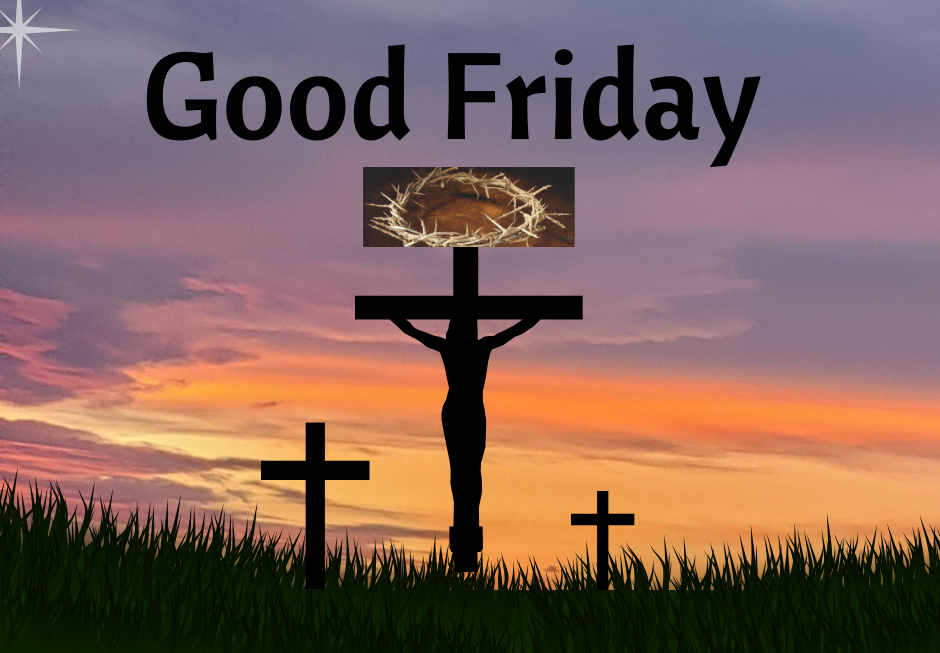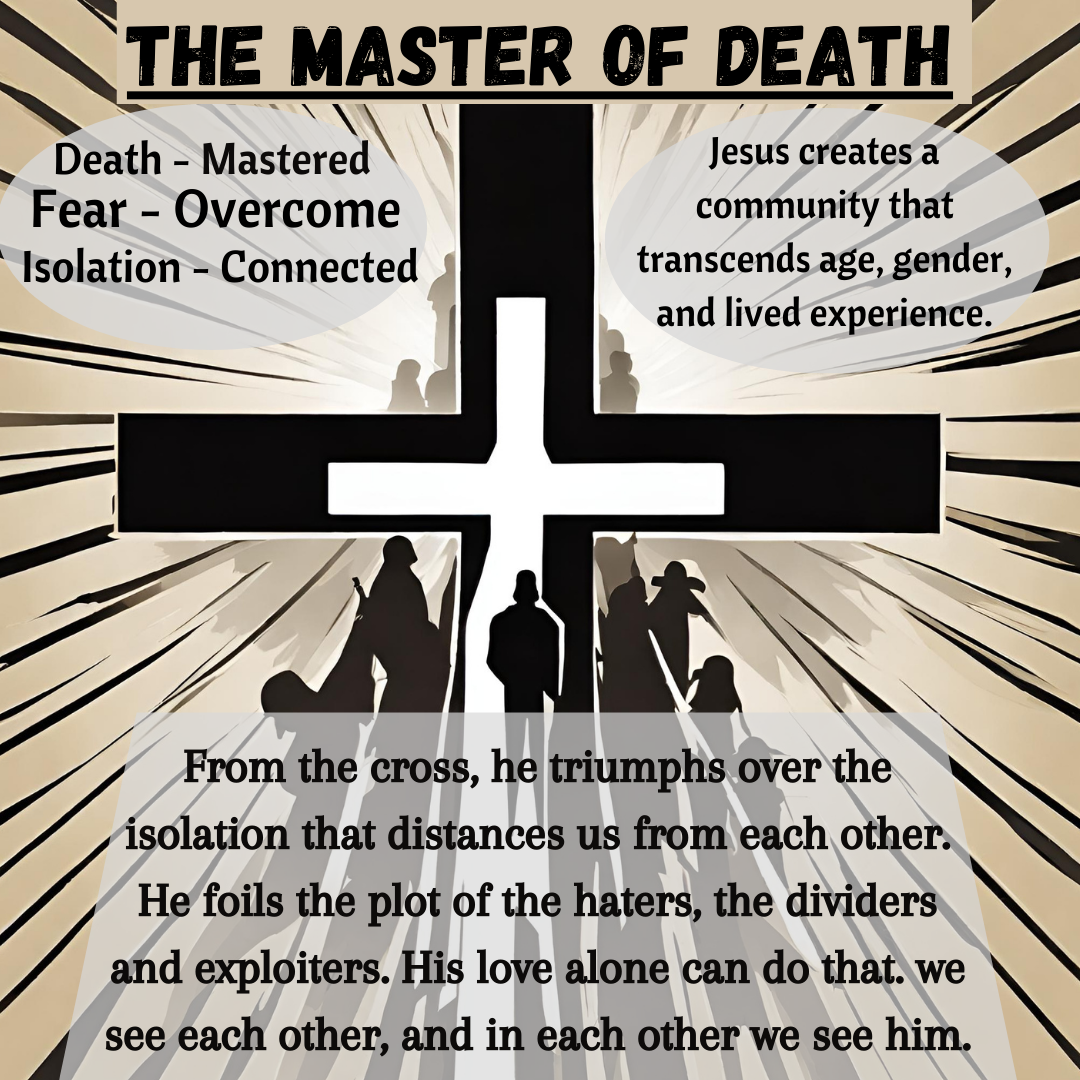DEATH MEETS ITS MASTER
John 19:16b-30
Good Friday
Analysis by Paul G. Theiss
16bSo they took Jesus; 17and carrying the cross by himself, he went out to what is called The Place of the Skull, which in Hebrew is called Golgotha. 18There they crucified him, and with him two others, one on either side, with Jesus between them. 19Pilate also had an inscription written and put on the cross. It read, “Jesus of Nazareth, the King of the Jews.” 20Many of the Jews read this inscription, because the place where Jesus was crucified was near the city; and it was written in Hebrew, in Latin, and in Greek. 21Then the chief priests of the Jews said to Pilate, ‘Do not write, “The King of the Jews”, but, “This man said, I am King of the Jews.”’ 22Pilate answered, ‘What I have written I have written.’ 23When the soldiers had crucified Jesus, they took his clothes and divided them into four parts, one for each soldier. They also took his tunic; now the tunic was seamless, woven in one piece from the top. 24So they said to one another, ‘Let us not tear it, but cast lots for it to see who will get it.’ This was to fulfill what the scripture says,
“They divided my clothes among themselves,
and for my clothing they cast lots.”
25And that is what the soldiers did.
Meanwhile, standing near the cross of Jesus were his mother, and his mother’s sister, Mary the wife of Clopas, and Mary Magdalene. 26When Jesus saw his mother and the disciple whom he loved standing beside her, he said to his mother, “Woman, here is your son.” 27Then he said to the disciple, ‘Here is your mother.’ And from that hour the disciple took her into his own home.
28After this, when Jesus knew that all was now finished, he said (in order to fulfill the scripture), ‘I am thirsty.’ 29A jar full of sour wine was standing there. So they put a sponge full of the wine on a branch of hyssop and held it to his mouth. 30When Jesus had received the wine, he said, ‘It is finished.’ Then he bowed his head and gave up his spirit.
“The Lord of the cosmos takes charge, even in death.”
Author’s notes: Although this study focuses on John 18:16b-30, its points are applicable to the longer version of the gospel for Good Friday. The preacher might choose to include in the presentation Salvador Dali’s famous painting “Christ of St. John of the Cross,” which depicts the crucifixion in Johannine perspective, the view from above. Another point to consider is the ubiquity of crucifixion in the ancient world. That gruesome, intimidating public spectacle would have been a visceral lived experience for John’s first readers/hearers, in a way it is not for us. But even in our time, media images vividly bring the suffering of others into our lives, often engendering a paralysis of helplessness and resignation in the face of tragedy.
DIAGNOSIS: Death, the Master
Step One: Initial Diagnosis (External Problem): Isolation
Jesus carries his cross, alone. His chief lieutenant has denied him. His church has rejected him. A government bureaucrat, who could rescue Jesus, has washed his hands of him. The fickle public has turned against him. We walk this way with Jesus. Anyone who takes a difficult stand on principle in a fallen world experiences isolation sooner or later. If we haven’t yet, we will – or perhaps we should. Either way, isolation will come, sooner or later. Read on.
Step Two: Advanced Diagnosis (Internal Problem): Fear
Jesus is dying of shock and asphyxiation at the mercy of his torturers. They even strip away his clothes, the last shreds of his dignity. Those of us who have experienced extreme pain know that it drives us into ourselves. It dominates, capturing us like a black hole sucking light into itself. A nimbus of agony surrounds the sufferer, separating them even from their own rational thoughts. With the loss of control comes fear. Ask yourself about your own fear, if you dare.
Step Three: Final Diagnosis (Eternal Problem): Death
A door that none of us have walked through as yet, but which none of us can escape. The door hangs in darkness – dare I touch it? What, if anything, lies on the other side? God, are you here? I can’t see you. We are all finally left isolated and fearful in the face of death and its judgment.
PROGNOSIS: The Master of Death
Step 4: Initial Prognosis (Eternal Solution): Death, Mastered
God’s Beloved takes a stand at the Place of the Skull. He confidently entrusts his spirit to his Father. Even the bullying cruelty of his captors and his agony of thirst fulfil Scripture, fulfil divine destiny for the world. Against all human hope and rationality, Jesus enters into death, the implacable enemy shrouded in fear, and takes charge over it. Only God Almighty can do this. Only God’s Son the Human One can do this, for us! “It is finished.” It is completed.
Step 5: Advanced Prognosis (Internal Solution): Fear, Overcome
“Perfect love casts out fear” (1 John 4:18). Striding into terror, Jesus’ commanding presence loves us out of our fear. The Lord of the cosmos takes charge, even in death. Pain no longer separates, but rather connects us to the suffering Christ. We are no longer alone, no matter how deep the misery. “And I, when I am lifted up from the earth, will draw all people to myself” (John 12:32).
Step 6: Final Prognosis (External Solution): Isolation, Connected
Drawing together two unrelated followers (his own mother and the disciple John), Jesus creates a community that transcends age, gender, and lived experience. From the cross, he triumphs over the isolation that distances us from each other. He foils the plot of the haters, the dividers and exploiters. His love alone can do that. Easter may not yet be visible, we may not yet fully see his victory, but we see each other, and in each other we see him. “All mine are yours, and yours are mine: and I have been glorified in them” (John 17:10).






You must be logged in to post a comment.